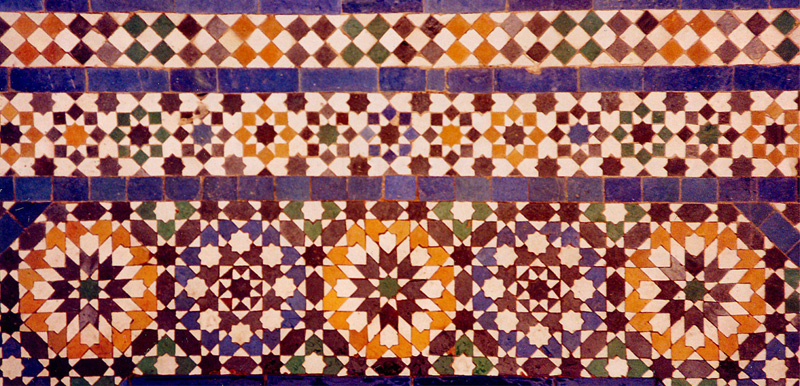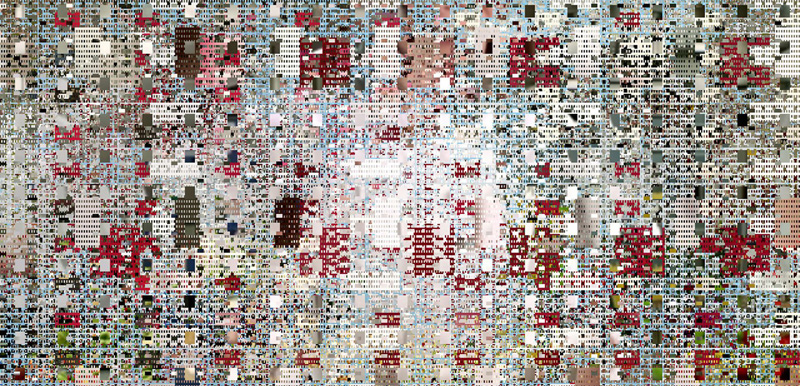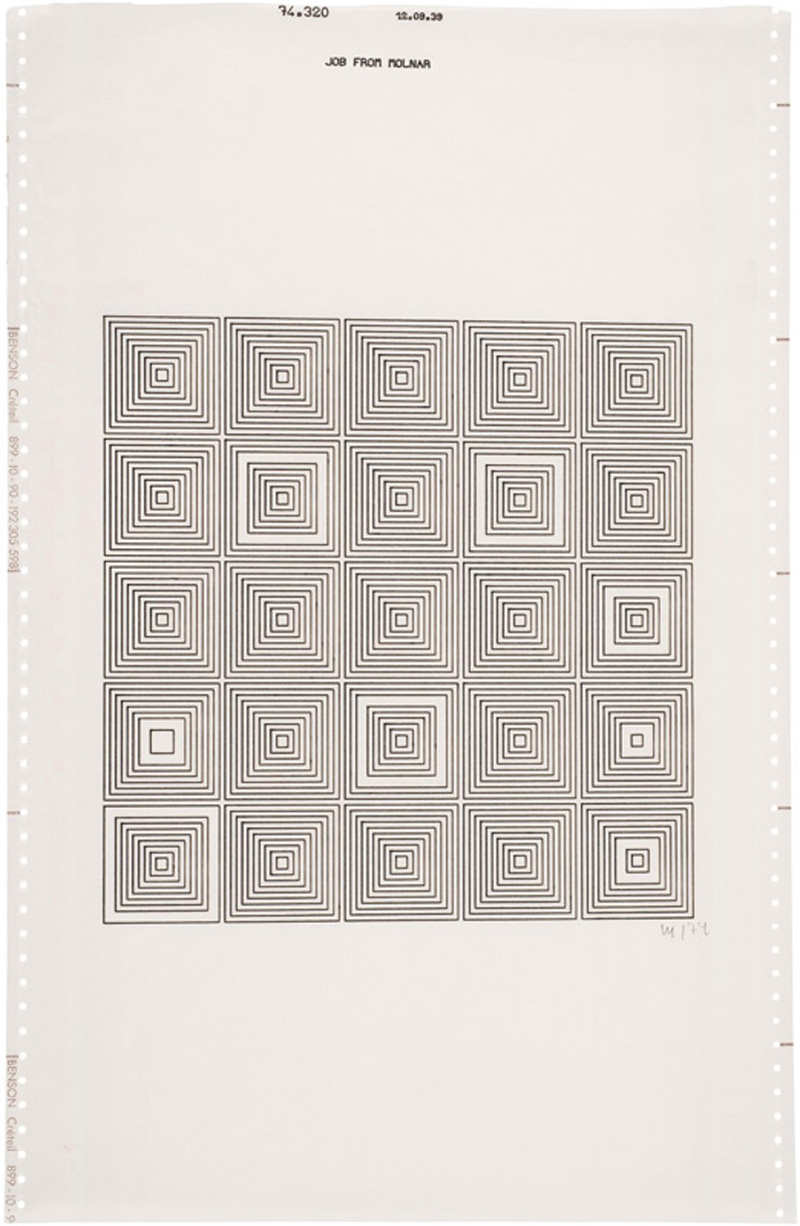Iterative Pattern

1. In Spamgetto (2009), the Italian design agency Todo presents computationally generated wallpaper whose elements include text from thousands of spam emails.
Brief
Write code to generate a tiling pattern or textural composition, as for wallpaper or fabric. Give consideration to aesthetic issues like symmetry, rhythm, color; detail at multiple scales; precise control of shape; and the balance between organic and geometric forms.
Your pattern should be designed so that it could be infinitely tiled or extended. Design something you would like to put on the walls or floor of your home, or that you could imagine yourself wearing. Export your pattern in a high-resolution format, and print it as large as possible for your peers’ review. Remember to sketch first.
Learning Objectives
- Create visual designs using the Cartesian coordinate system and combining drawing functions
- Use functional abstraction to encapsulate the code for modular design elements
- Generate and critique designs with symmetries and/or seamless repetition
Variations
- Experiment with 2D graphics transformations, such as rotation, scaling, and mirror reflections.
- Use nested iteration to develop 2D rhythms or other gridlike visual structures.
- Create a helper function to abstract the way in which a complex visual element (such as a flower, animal, fruit, or fleur-de-lis) is rendered throughout your design.
- Reproduce a preexisting textile or wallpaper design using code only.
- Make a kaleidoscope by incorporating a photographic image or video feed into a pattern with symmetric reflections.
- Have your pattern printed on real fabric or wrapping paper. Consider other output devices or on-demand services for realizing your pattern, such as computer-controlled laser cutters, knitting machines, or lace-making machines.
- Make an animated “dynamic wallpaper” loop to use in the background of your videoconferences. Your design should scale gracefully by rendering correctly at different canvas resolutions.i
Making It Meaningful
Pattern is the starting point from which we perceive and impose order in the world. Examples of functional, decorative, and expressive pattern-making date from ancient times and take the form of mosaics, calendars, tapestry, quilting, jewelry, calligraphy, furniture, and architecture. There is an intimate connection between pattern design, visual rhythm, geometry, mathematics, and iterative algorithms. This prompt invites the creator to hone their understanding of these relationships in formal terms. An important variation of this prompt is to realize designs physically, through either digital printing, fabrication in an unusual material, or at an unexpected scale. This can be a watershed moment of synthesis for software artists who crave making something physical.

2. Georg Pólya's illustrations (1924) of the seventeen periodic plane symmetry groups had a profound influence on the algorithmic patternmaking of M. C. Escher.

3. Zellige terracotta tiles in Marrakech (17th century) form edge-to-edge, regular, and other tessellations.

4. Casey Reas's One Non-Narcotic Pill A Day (2013) presents a dynamic collage pattern generated from a video recording.

5. Alison Gondek, a scenic design student at Carnegie Mellon studying introductory programming, used p5.js to create this pattern inspired by the “Circular Gallifreyan” language from Doctor Who.

6. Vera Molnár was among the first artists to use a computer. Her 1974 untitled plotter drawing demonstrates patterns arising from the interaction between procedural iteration and randomized omission.

7. Leah Buechley explores the intersection of computation and craft. The design of her lasercut curtain (2017), generated in Processing, features multiple forms of iteration and controlled randomness.
Additional Projects
- Dave Bollinger, Density Series, 2007, generative image series.
- Liu Chang, Nature and Algorithm, 2016, algorithmic images, satellite imagery, ink on paper.
- Joshua Davis, Chocolate, Honey and Mint, 2013, generative image series.
- Saskia Freeke, Daily Art, 2010–2020, generative image series.
- Manolo Gamboa Naon, Mantel Blue, 2018, ink on paper.
- Tyler Hobbs, Isohedral III, 2017, inkjet print on paper, 19 x 31”.
- Lia, 4jonathan, 2001, generative image series.
- Holger Lippmann, The Abracadabra Series, 2018, generative image series.
- Jonathan McCabe, Multi-Scale Belousov-Zhabotinsky Reaction Number Seven, 2018, generative image series.
- Vera Molnár, Structure de Quadrilateres (Square Structures), 1987, ink on paper.
- Nontsikelelo Mutiti, Thread, 2012–2014, screen print on linoleum tiles.
- Nervous System, Patchwork Amoeba Puzzle, 2012, lasercut plywood.
- Helena Sarin, GANcommedia Erudita, 2020, inkjet printed book.
- Mary Ellen Solt, Lilac, 1963, concrete poetry.
- Jennifer Steinkamp, Daisy Bell, 2008, video projection.
- Victor Vasarely, Alom (Rêve), 1966, collage on plywood, 99 1/5 x 99 1/5”.
- Marius Watz, Wall Exploder B, 2011, wall drawing, 9 x 3.6 m.
Readings
- David Bailey, David Bailey's World of Escher-Like Tessellations, 2009, tess-elation.co.uk.
- P. R. Cromwell, “The Search for Quasi-Periodicity in Islamic 5-fold Ornament,” The Mathematical Intelligencer 31 (2009): 36–56.
- Anne Dixon, The Handweaver's Pattern Directory: Over 600 Weaves for 4-shaft Looms (Loveland, CO: Interweave Press, 2007).
- Ron Eglash, African Fractals: Modern Computing and Indigenous Design (New Brunswick, NJ: Rutgers University Press, 1999).
- Samuel Goff, “Fabric Cybernetics,” Tribune (blog), August 23, 2020.
- Branko Grünbaum and G. C. Shephard, Tilings and Patterns (New York: W. H. Freeman & Company, 1987).
- “Wallpaper Collection,” Collections, Historic New England, historicnewengland.org.
- Owen Jones, The Grammar of Ornament (London: Bernard Quaritch Ltd., 1868).
- Albert-Charles-Auguste Racinet, L’Ornement Polychrome (Paris: Firmin Didot et Cie, 1873).
- Casey Reas et al., {Software} Structures, 2004–2016, artport.whitney.org.
- Petra Schmidt, Patterns in Design, Art and Architecture (Vienna: Birkhäuser, 2006).